Library Board Briefed on Bike Share Program
Ann Arbor District Library board meeting (Aug. 19, 2013): A meeting with no major action items stretched into one of the longest sessions for the library board in recent years, with multiple presentations from staff and a briefing on the bike share program.

The logo for Ann Arbor-based Ghostly International was part of a presentation on digital content licensing at the Aug. 19, 2013 Ann Arbor District Library board meeting. (Photos by the writer.)
Heather Seyfarth of the Clean Energy Coalition described a new bike share program that CEC is managing, with a targeted launch of April 2014. One of the proposed bike stations could be located on library property at AADL’s downtown building, on South Fifth Avenue next to Library Lane. The library isn’t being asked to invest in the project, which is a partnership between CEC, the University of Michigan, the Ann Arbor Area Transportation Authority and the city of Ann Arbor. However, locating a station on AADL property would require a formal agreement between the library and CEC.
Seyfarth noted that the program doesn’t yet have a name, and organizers plan to ask the public for suggestions. They had originally settled on GoBike, but that name is already trademarked by another organization.
Trustees were also updated by library staff on activities related to goals in the five-year strategic plan, from 2010-2015, and on the latest direct licensing agreements that the library has reached with authors and musicians. Regarding the licensing deals, AADL director Josie Parker pointed out that the library staff decided not to pursue some options that are available to libraries, such as Freading and Zinio. In those other approaches, there is a go-between handling the licensing deals with authors and artists. She noted that at this point, AADL is in the minority as it pursues direct licensing. Some of those deals are with local authors and organizations, including indie label Ghostly International and graphic novelist Jim Ottaviani.
Trustees also received a briefing on a new format for presenting AADL statistics in five categories: Collections, users, usage, visits and participation. Eli Neiburger, AADL’s associate director of IT and product development, showed data in these categories using bar graphs and charts, and talked about the meaning behind the numbers. New information was also included in the report, like the value of the total AADL collection – estimated at $16.1 million, based on the replacement cost of all items in the AADL catalog.
In one of its few action items, the board approved three minor adjustments to the 2012-13 budget, for the prior fiscal year ending June 30, 2013. The adjustments totaled $11,000. Trustees also passed a resolution thanking Vicki Browne on her recent retirement. She had worked at the AADL since 1988.
During committee reports, Margaret Leary – chair of the facilities committee – noted that committee members had given Parker the go-ahead to get cost estimates for renovating the entry of the downtown library, including replacement of the front doors. It’s not yet clear if the project would require board approval.
Though not an agenda item, the library’s contract with Allerton-Hill Consulting emerged on several occasions during the meeting, including public commentary. Board president Prue Rosenthal also made a brief statement in response to public commentary at previous meetings. She stressed that “the board of the Ann Arbor District Library has done nothing illegal,” she said. “We are not in violation of the Michigan law.” Members of the Protect Our Libraries political action committee have questioned whether board’s committee meetings, which do not include a quorum of board members and are not open to the public, comply with the Michigan Open Meetings Act.
Allerton-Hill Contract
The topic of the library’s contract with Allerton-Hill Consulting came up several times during the Aug. 19 meeting.
Allerton-Hill Contract: Meeting Minutes
Near the start of the meeting, Margaret Leary asked for a correction to the minutes of the July 15, 2013 meeting. She suggested that in the future, when people read their own statements or other documents, they should be clear when they’re starting and ending a quote. Otherwise, anyone reading the minutes “can’t tell what’s what,” she said.
Leary proposed modifications to page 15 of the board packet – a section that transcribes public commentary from Bob Rorke, who read excerpts from email exchanges that the Protect Our Libraries political action committee obtained through a Freedom of Information Act request. Leary’s proposal modified the minutes to indicate when he was reading from emails, and when he was making his own statements. [.pdf of July 15, 2013 meeting minutes]
She stressed that she did not state: “This contract is not wise. It’s not a generic communication audit. It’s communication project.” Leary added. “I did not say that, and I don’t want our minutes to make it look as if I said that. It was Mr. Rorke.”
Allerton-Hill Contract: Response to Previous Public Commentary
After the board approved the amended minutes, board president Prue Rosenthal made a brief statement regarding the Allerton-Hill contract. “I want to make it very clear to our board and the community that Allerton-Hill did not contract to do a survey, and the library is not going to do a survey. The library is not going for a bond in 2013. I want to reiterate that the board of the Ann Arbor District Library has done nothing illegal. We are not in violation of the Michigan law. We consult with our lawyers about any move we make that would be a concern, and we have done nothing that has violated any Michigan law.”
At previous meetings during public commentary over the past several months, some speakers have questioned whether the board has violated the Michigan Open Meetings Act by not opening its committee meetings to the public. Although the meetings of the board are required to comply with OMA, there is no requirement that committee meetings – attended by less than a quorum of the board – be open to the public.
Rosenthal had made a previous statement in defense of the board at its May 6, 2013 meeting, when she more explicitly addressed the issue of committee meetings.
Allerton-Hill Contract: Public Commentary
During public commentary on Aug. 19, Libby Hunter told the board that she’s aware that the library hired Allerton-Hill for $28,000. It’s a bill paid by the taxpayers, she noted. The stated goal is to improve communication with the public, Hunter said, but there are some effective, simple and much more cost-effective ways that could help achieve that goal. Hold the board meetings on nights when the Ann Arbor city council doesn’t meet, she suggested. The Protect Our Libraries PAC has looked at when other public bodies meet, Hunter added, and there are other nights of the week when there are no conflicts.
Another way to improve communication would be to televise board meetings, Hunter said. The equipment is already in place to do that, and other public entities use the AADL boardroom precisely because of those capabilities, she noted. [The boards of the Ann Arbor Public Schools and Ann Arbor Area Transportation Authority hold meetings in the AADL fourth-floor boardroom, where the AADL board also meets. The AAPS and AAATA board meetings are televised.] Televised meetings in this community have become standard, Hunter said. Finally, she suggested opening up all committee and subcommittee meetings to the public.
At the end of the meeting, Bob Rorke apologized for not providing a copy of his previous remarks to include in the minutes, which led to a lack of clarity. “I had no intention of putting words in your mouth,” he told Leary. “I will correct that.”
As for Rosenthal’s comments that there would be no bond proposal in 2013, Rorke said that he understood that. His question to trustees and administration is whether there’s any talk about a bond referendum in 2014 or some other proposal to replace the downtown library. He was also interested in hearing that no survey is planned by Allerton-Hill, and he wondered if there is any other contract being considered for a survey this year or next year. Finally, he wanted to know if any trustees or the administration have discussed the possibility of a bond proposal with Allerton-Hill.
Allerton-Hill Contract: Communications Committee
Nancy Kaplan, who chairs the board’s communications committee, reported that the committee had met on Aug. 14 and received an update from Allerton-Hill consultants. The committee is expecting to receive a written report in a couple of weeks, she said, noting that it will be a public document. She pointed out that the communication audit and planning is part of the library’s five-year strategic plan, from 2010-2015, under strategic initiative #4. The reason why the library is doing this communication audit is that it’s in the strategic plan, Kaplan said. The committee will meet again when the report is available, she said.
Members of the communications committee include Kaplan, Margaret Leary and Ed Surovell.
Bike Share Program
Heather Seyfarth, a program supervisor with the Ann Arbor-based Clean Energy Coalition, briefed the board on a new bike share program that will be launched in Ann Arbor. Part of the nonprofit’s mission is to provide clean forms of transportation, and bicycling is about the cleanest possible form aside from walking, she said.
Bike sharing differs from bike rentals, which are typically used for leisurely rides, Seyfarth explained. “This is really meant to get from Point A to Point B – to be another transit option.”
In earlier iterations, bike sharing faced problems because systems weren’t in place to prevent bikes from being stolen. Today, Seyfarth said, technology is available to check out bikes securely, to pay for access with credit cards, and to do transactions online. GPS systems are also in place to track where the bikes are located.
The bikes used in the program are made by Trek, she said, and are “incredibly durable.” Seyfarth showed examples of other successful programs in Boulder B-cycle in Boulder, Colo.; Madison B-cycle in Madison, Wisc.; Capital Bikeshare in Washington D.C.; and Nice Ride Minnesota in Minneapolis.
B-cycle won the Ann Arbor contract. But although most B-cycle bikes in other cities are red, the bikes in Ann Arbor will be blue, Seyfarth reported. There had been discussion about that, she added. “What we heard was that we couldn’t go with the red bikes because of Ohio.” [The colors of Ohio State, a University of Michigan rival, are scarlet and gray.] Ed Surovell quipped: “It took somebody else to tell you that?”
When the program launches, you can join as an annual member, or pay on a daily or weekly basis, Seyfarth explained. You can check out your bike from one station, then return it at another location near your destination.
The University of Michigan is still vetting potential locations on its north and central campuses, she said. Potential stations in Ann Arbor could be located at: (1) Ashley & Liberty; (2) Fifth Avenue & Library Lane; (3) Liberty & Division; (4) Kerrytown, at Detroit & Fifth: and (5) South State & Hoover.
Staff from Clean Energy Coalition, the university, the city of Ann Arbor and B-cycle will be talking to property owners near these proposed locations before making final decisions about where to put the bike sharing stations, Seyfarth said.
Seyfarth described environmental and economic benefits to bike sharing. There’s also evidence in other communities that bike sharing increases the use of public transit, she said, because you can use the bike for the last leg of your trip. It fosters a sense of place and adds to the vibrancy of a community, she added.
The partners in this program – the city of Ann Arbor, UM, the Ann Arbor Area Transportation Authority, and the Clean Energy Coalition – have been meeting for almost two years, Seyfarth said. The Ann Arbor Downtown Development Authority has also been involved, she said.
In relating the history of this project, Seyfarth noted that in 2012, the Clean Energy Coalition received a $600,000 Federal Highway Administration Congestion Mitigation Air Quality (CMAQ) grant – for which the AAATA is the fiduciary. The nonprofit issued a request for proposals (RFP), and selected B-cycle as the program vendor. One reason for choosing B-cycle is that if someone has a membership in Ann Arbor, they can use it in any other community where B-cycle operates.
The federal grant is for capital expenses – bikes and stations – and is matched with $150,000 from the city’s alternative transportation fund. [The local match was approved by the city council at its Aug. 8, 2013 meeting on a 9-2 vote, with dissent from Sally Petersen (Ward 2) and Marcia Higgins (Ward 4).]
The total project budget is $1.5 million over three years, with a target launch date of April 2014. The initial size will be 14 stations with 125 bikes. Operations will be supported in the first three years of the program by UM at a level of $200,000 annually for a total of $600,000, plus an estimated $200,000 in memberships and user fees.
The plan is to hire a full-time program manager, who’ll be in charge of a couple of technicians, she said. Additional revenues are expected to come from sponsorships, Seyfarth reported, including a $25,000 sponsorship already secured from Google. Another $5,000 has been committed from Trans4M, a statewide transportation coalition. Other organizations – including Zingerman’s, Bank of Ann Arbor and Meijer – have expressed interest too, she said.
Sponsorship revenue could be used to expand the program, Seyfarth said. Briarwood Mall has approached the Clean Energy Coalition, wanting to put a station there. People have also asked about whether there will be stations at park-and-ride lots, hospitals and other locations, she said.
For the first year, in 2014, the program is projected to have 3,500 24-hour memberships, 75 weekly memberships, and 875 annual memberships. It would be open from April 22 through Nov. 30.
Bike Share Program: Board Discussion
Rebecca Head noted that if the program opens on April 22, that’s just about the time when most UM students are leaving town. Has there been any thought about starting it earlier? Yes, Seyfarth replied, but for this first year, it’s logistically not possible to get everything done earlier than April. In subsequent years, they’d like to open as early as possible.

Heather Seyfarth of the Clean Energy Coalition gave a presentation on the new bike sharing program that’s expected to launch in April of 2014.
Margaret Leary asked about the business plan. Do organizers expect a high percentage of revenues to come from sponsors? Or at some point, will operations be supported primarily from members? Seyfarth said it’s not likely that the program could be supported only through memberships. In other communities, large sponsorships are sought. Leary wondered if that model was sustainable, long-term. Seyfarth expressed optimism, and noted that UM has pledged a three-year commitment that might be continued “though we’re not counting on that, necessarily.”
Nancy Kaplan asked about helmets – would people using B-cycle be riding without helmets? Seyfarth noted that this question arises frequently. Most bike share programs don’t include helmets, and it’s not a requirement in Michigan. But it’s a concern, she added, and so they’re looking at options. One option is to have vending machines with helmets. Another option would be to partner with businesses that are adjacent to the bike stations, so that those stores could sell helmets. That could be an economic development connection, she said, as a way to get people into local shops. Or perhaps there could be a helmet sharing program.
In other communities, she noted, people tend to bring their own helmets when they use the bike.
AADL director Josie Parker said that she had asked Seyfarth to give this presentation because it’s important for the board to know that the location at Fifth & Library Lane would likely be on library property, not city property. There haven’t yet been conversations about whether it would be a permanent or moveable station, Parker added.
Sponsorship could also matter to the board, Parker said, because people generally assume that whatever is on library property is approved and sanctioned by the library. The board should think about what questions they’d like to ask as this process moves forward, she said.
Leary asked if organizers had considered putting a bike station across the street from the downtown library at the AAATA’s Blake Transit Center. That’s been considered, Seyfarth replied, but the spot next to the library could more easily accommodate a station.
Seyfarth clarified that the library would not need insurance, even if it’s on library property. As owners and operators of the program, the Clean Energy Coalition will carry insurance on the stations, she said. In response to a query from Leary, Seyfarth said there would eventually be a written agreement with the library, before a station would be located there.
Seyfarth also noted that the program doesn’t yet have a name, and organizers plan to ask the public for suggestions. They had originally settled on GoBike, but that name is already trademarked by another organization.
Board president Prue Rosenthal called it a wonderful program, and other board members generally seemed supportive.
Outcome: This was not a voting item.
Digital Content Licensing Update
Eli Neiburger, AADL’s associate director of IT and product development, gave an update on AADL’s efforts at direct licensing of digital content. He had given a similar presentation a year ago at the board’s Aug. 20, 2012 meeting.
The library has been pursuing direct licensing with several rightsholders. The library continues to provide access to eBooks through a proprietary service called Overdrive, which allows the library to buy temporary licenses for eBooks. There are challenges with Overdrive, he noted, like the fact that books can be used by patrons only one at a time. There are also certain technical requirements to use Overdrive, and a lot of people don’t make it through that process of updating software and making other modification before they can use the service.
One decision that the library has made is not to invest money in technology that restricts access to content, Neiburger said. As a result, AADL has pursued its own licensing agreements with “rightsholders that understand the nature of the web, instead of attempting to build a business model in defiance of the web,” he said.
In 2011, the library reached an agreement with Magnatune, a digital music publisher. That collection now has about 1,400 albums and almost 20,000 tracks. It’s great for choral music, classical music, and jazz. “What is missing from this collection are artists with which people are previously acquainted,” he quipped. If a musician has signed with a major label, they’re not allowed to release their music in this way. But Magnatune’s collection is high quality, he said, and users tend to stream the music all day.
The first eBook that AADL licensed was a graphic novel titled “Poopy Claws,” about a boy and his cat, Stinky, who doesn’t use the litter box. The license is for four years and has been popular, Neiburger said. It’s a downloadable .pdf file and after you download it, “it’s yours to keep,” he noted. The library also licensed the 2009 “Grown in Detroit” documentary, which has been streamed thousands of times, Neiburger reported.
He then described some of the newer licensing agreements. That includes a deal with Front Porch Romance, a publisher of romance eBooks based in Sterling Heights. The Front Porch Romance books are known in the trade as “sweet” romance, Neiburger noted, as opposed to “spicy” romance, and many are novellas.
Another agreement is with Tristan Gregory, a local writer of fantasy and science fiction. Because Gregory is not working with a publisher, Neiburger said, he retained the rights to his material and could make a deal directly with AADL. The license includes unlimited downloads through the term of the agreement. After that, the license is either removed, or AADL will delete the books from their computer servers. But anyone who has downloaded the books can keep them, Neiburger said. Gregory’s eBooks will be added to the AADL collection soon.
Jim Ottaviani, a University of Michigan librarian and graphic novel author, is licensing two works to AADL: “Fallout,” about J. Robert Oppenheimer and the Manhattan Project; and “Two-Fisted Science,” a collection of vignettes about famous scientists.
The library is also licensing the entire catalog of music by Jonathan Coulton, an indie pop musician who has toured with They Might Be Giants and who’s the house musician on NPR’s newest quiz show, “Ask Me Another.” The 10-year license is for unlimited downloads. About a third of the collection has already been released online, Neiburger said, but the other two-thirds is only for sale if you buy it directly from him. It will now be available to AADL patrons.
Laura Pershin Raynor, a member of the AADL staff, will be licensing her two Storytime CDs to the library. “These are not necessarily kid-friendly stories, but they’re not necessarily kid-unfriendly stories,” Neiburger said. They’re geared for adults.
Finally, the library recently finalized a licensing agreement with Ghostly International, which Neiburger described as “Ann Arbor’s own super-hip record label.” AADL has licensed 262 albums and 1,588 tracks.
The key aspect of AADL’s approach is to license directly with individuals and entities that own their work, Neiburger said.
Responding to an email query from The Chronicle after the meeting, Neiburber provided information about the cost and duration of these licensing deals:
- Front Porch Romance: $5,000 – expires July 31, 2014.
- Jim Ottaviani: $625 – expires July 31, 2014.
- Tristan Gregory: $250 – expires July 31, 2014.
- Jonathan Coulton: $1,000 – expires July 31, 2023.
- Laura Pershin Raynor: $600 – expires July 31, 2015.
- Ghostly International: $7,000 – expires July 31, 2014.
Neiburger noted that these were expenditures for fiscal 2012-2013, which ended July 31, 2013. The deals represent about 10% of that year’s total AADL licensing budget, and less than 1% of that year’s materials budget, according to Neiburger.
Digital Content Licensing Update: Board Discussion
Nancy Kaplan asked whether teenagers would be able to access material that’s meant for adults. “Just like the shelf – yes,” Neiburger replied.
Ed Surovell noted that the library, through these licensing deals, provides “an enormous format for marketing.” It’s no different than a very good bookstore, he said, except that it’s available for free to patrons. That’s a massive value for patrons, he said.
AADL director Josie Parker pointed out that the library staff decided not to pursue some other options that are available to libraries, including Freading and Zinio. In those other approaches, there is a go-between handling the licensing deals with authors and artists. The library wouldn’t know how much the go-between is paying the license-holder, or what the mark-up is for the library. Also, the patron who downloads material from these services wouldn’t necessarily get to keep it, Parker said.
With AADL’s approach of direct licensing, the library isn’t paying for each download or click, Parker explained. In the other models, there would be costs for downloads and clicks. It’s more costly in other ways, too. For example, Zinio charges a $40,000 set-up fee, plus additional costs per title, she said.
In the library world, AADL is very much in the minority in taking this direct-licensing approach, Parker noted. Other libraries are asking questions about it, but not pursuing it. For example, AADL is still the only public library that has a contract with Magnatune, she said. “It’s going to be interesting to see how it plays out, for us and for the broader publishing industry and libraries.”
Huge amounts of money are being spent by libraries across the country on digital content, “and we’re appalled that that’s happening,” Parker said.
Prue Rosenthal asked about the licensing model. Does the library pay more if an item is downloaded frequently? No, Neiburger replied. The library pays a flat fee for the term of the license, for unlimited downloads. If the content is used a lot, then the library gets a better value. “It’s the same thing that libraries have been doing for centuries – aggregating the buying power of the community, and we take the risk of it being used or not,” he said.
Margaret Leary stressed how much she respected the ability and courage of AADL staff at developing this new approach. “It’s contrary to the way librarians have always done things,” she noted. Academic libraries, for example, are spending millions of dollars to license digital content every year, but don’t get to keep anything. Meanwhile, these libraries are under space constraints to get rid of paper copies, “which locks them in to forever having to pay these expensive prices,” Leary said. “It’s having a very bad impact on the publishing industry and access to information.”
Even though AADL’s licensing deals are modest at this point, “it has the potential to explode,” Leary said.
Outcome: This was not a voting item.
Financial Report
Ken Nieman – AADL’s associate director of finance, HR and operations – gave a brief report on the July 2013 financial statements included in the board packet. [.pdf of financial statements]
The unrestricted cash balance of $7.8 million is about the same as it was in June, he said. As of July 31, the library has received 9.5% ($1.08 million) of its budgeted tax receipts. The bulk of revenues from property taxes come during August and September, he noted. [The library's fiscal year starts July 1. Summer property taxes are collected in July.]
Four items are currently over budget, after one month into the new fiscal year, which is normal at this point because of large purchases made in July, Nieman reported. The over-budget line items are: (1) employment costs related to merit increases; (2) purchased services; (3) communications, for an annual Internet-related payment; and (4) software.
There was nothing out of the ordinary, he concluded.
Financial Report: Board Discussion
Nancy Kaplan asked about the 2013 library penal fines distribution, wondering if it was the amount that Nieman had expected. [Revenues from state level penal fines are required by the state constitution to fund libraries. Those penal fines include: firearms violations, hunting and fishing violations, dog law violations and traffic violations.]
Nieman reported that penal fine revenues had been about $26,000 more than AADL had budgeted for FY 2013. That variance will be reflected in the audit.
Outcome: This was not a voting item.
Budget Adjustments
On the Aug. 19 agenda was a resolution to approve three minor adjustments to the 2012-13 budget, for the prior fiscal year ending June 30, 2013. The adjustments totaled $11,000.
Ken Nieman – AADL’s associate director of finance, HR and operations – had previously indicated that such adjustments would be necessary. At the board’s July 15, 2013 meeting, he told the board that three items were over budget for the year ending June 30: utilities, communications and software. The board made some budget adjustments at its June 17, 2013 meeting based on estimates that turned out to be too low. Nieman had said the board would be asked to make additional adjustments to the previous year’s budget at its August meeting for these three line items.
The Aug. 19 resolution was to transfer $8,000 from capital outlays – moving $4,000 to the utilities line item, and $4,000 to the communications line item. Another transfer shifted $3,000 from circulation supplies to the software line item.
Outcome: Without discussion, the board authorized adjustments to the 2012-2013 budget.
Library Statistics
Eli Neiburger, AADL’s associate director of IT and product development, briefed the board on a new monthly format for presenting AADL statistics. Typically, the board receives information in grid format. [.pdf of statistics in grid format for July 2013 – Part 1] [.pdf of statistics in grid format for July 2013 – Part 2] Data includes circulation numbers, new cards issued, website page views and other information.
In introducing the presentation, AADL director Josie Parker said the new format – using charts and bar graphs – would include more detailed information, shown in a way that would give the board a better idea of what goes on at the library.
Neiburger told the board that one of the hardest things to do is to find meaningful comparisons when organizing statistics. His presentation included a comparison between July 2013 and July 2012. [.pdf of statistics in new chart-and-graph format]
He reminded the board that much of what goes on in a library can’t be counted. “There are a lot of things that go on and a lot of ways that people can use the building that cannot be captured by statistics, and that will never show up on an Excel spreadsheet.”
The information was organized into five categories: Collections, users, usage, visits and participation. The charts showed data for both tangible (physical) and digital (online) aspects of the AADL.
Neiburger walked the board through each of these charts, giving descriptions for each item and explaining some of the variances compared to 2012. He also highlighted some information that staff hadn’t previously calculated, like the value of the total AADL collection – estimated at $16.1 million, based on the replacement cost of all items in the AADL catalog.
Going forward, the staff intends to focus on one area in detail each month, Neiburger said, and they could also include any additional data that interests the board.
Parker told the board that trustees would be provided with the data in both the traditional and new formats, if that’s what they’d like.
Ed Surovell commented on the enormous amount of services and activities that have to be managed and staffed – that’s reflected in the data, he said. “And virtually all of them involve individual decisions.” The charts and graphs are really a management tool in how to keep the library vibrant, Surovell said.
Parker said the staff has to remind itself that this data isn’t “native” to most people who look at it, and it’s the staff’s responsibility to explain what it means.
Neiburger referenced remarks that Parker made in her director’s report (see below) about how libraries have always gone through transitions. “Formats rising and falling is what libraries have always been about,” he said. “It’s just that we had one [format (books)] that stuck around for a very long time.” The library is in the “content business,” he noted, regardless of the format. And in some ways, books were an anomaly in being the primary format for so long, he said.
Barbara Murphy expressed surprise at the number of reference questions that are still fielded by the library. The assumption is that with widespread Internet usage, she noted, people wouldn’t need reference librarians.
Margaret Leary liked how the new presentation of statistics highlighted the mix of tangible and digital. That’s really important now, she said, as people wonder how the library is accommodating to new formats or, on the other hand, not abandoning the book. “I think that this shows that AADL is doing both.”
Leary also pointed out that these statistics reflect the many ways that AADL allows users to let the library know what they want. “There have been implications over the last year that the library doesn’t listen to its users,” she said. “And we do listen to our users. There are lots of ways to listen to our users.”
Outcome: This was not a voting item.
Facilities
The board has six committees: communications, budget and finance, facilities, policy, director’s evaluation and executive. Two of those – communications and facilities – were created as special committees at the board’s Jan. 21, 2013 meeting. And on Aug. 19, the board heard updates from those two special committees. The other committees had not met over the past month. The report on the communications committee is included above in the Allerton-Hill section of this article.
Margaret Leary, who chairs the facilities committee, reported that the group had met on July 16. [Other members include Ed Surovell and Rebecca Head.] The agenda included an update from Ken Nieman about the general condition of the library’s facilities. There was nothing out of the ordinary, Leary said.
Another agenda item at the committee meeting was consideration of maintenance and upgrades to the downtown building. AADL director Josie Parker had told the committee about problems with the building’s front doors. They’ve been breaking frequently and are unreliable, and Parker would like to replace them. The committee agreed that Parker could seek outside professional advice about possible solutions to that problem. Options will come back to the facilities committee, which will vet them, Leary said. If it’s necessary to take action that requires board approval, she added, then the committee will bring a proposal to the board.
Facilities: Board Discussion
Barbara Murphy said she was pleased that problems with the front doors are being addressed. She’s always felt it was dark under the overhang. “Whatever they do, I’m sure they won’t put in another overhang,” she said, adding that in some ways, the change will open up the library’s entrance.
Prue Rosenthal asked what’s wrong with the doors. Josie Parker replied that the doors are old and the metal is “fatigued.” The hinges break and must be replaced frequently, she said, and sometimes the doors won’t close or open. The doors are airlocked, so there’s a lot of pressure exerted on them. The front entry had been redone a few years ago to accommodate construction on Fifth Avenue and the adjacent underground parking garage. It was not necessarily a permanent solution, Parker noted. Her hope is to get some options about how to improve the entrance, including the door replacement.
Nancy Kaplan asked about the project’s timeframe. Parker said she wanted to make sure it was acceptable to the board. Now she’ll ask an architect to give an opinion about what’s involved and to look at the “domino effect” for a project like this. When work is done on one area, it might affect other parts of the building. When she has secured cost estimates, she’ll bring it back to the facilities committee for review.
Facilities: Public Commentary
During public commentary, Don Salberg also addressed the issue of facilities – specifically, some concerns that had been voiced about the status of the downtown library building at 343 S. Fifth. Prior to the November 2012 ballot referendum on a bond to build a new downtown library, which was defeated, there were three issues raised, he noted. The first was inadequate power that prevented some patrons from hooking up their electronic devices. He thanked AADL director Josie Parker for meeting with him, and informing him that new power strips have been installed for laptop use. So apparently that problem has been resolved, he said.
Another issue was the building’s compliance with the Americans with Disabilities Act (ADA), he said. There was a question related to the elevators and other areas. Salberg said Parker told him that the building was in compliance with ADA “and I’m very happy to hear that.”
Finally, there was some concern about whether the heating and cooling units would need to be replaced soon. Salberg said he’s been told that the units are currently working well, and that it’s difficult to predict when they’ll need replacement. It could be years, he said.
Salberg commended Parker and AADL staff for being excellent stewards of the library.
Director’s Report
AADL director Josie Parker briefed the board on several items, including some that were part of her one-page written report. [.pdf of August director's report] Highlights include:
- A life-sized Angry Birds event was held at the Washtenaw County Meri Lou Murray recreation center on July 22, drawing about 400 people as part of AADL’s summer game. The big takeaway for the library was a partnership with the rec center staff, Parker said, and the county’s interest in doing more events together.
- The 8th annual Lego contest was held on Aug. 8 at the Kensington Court Hotel, with 185 entries and more than 500 people attending the awards ceremony. Prizes are paid for by the Friends of the AADL. In the adult category, the 1st prize was given to a model of a Koi pond with life-size heron. The 2nd prize was for a model of Blimpy Burger, with snow bears and a long line of customers.
- A report from the Online Computer Library Center Inc. (OCLC) – “The Big Shift” – was included in the board packet. [.pdf of The Big Shift report] The report examines public access to information in any format, Parker said, and the suggestions in the report are things that the AADL already does. She said AADL is looking at it as a transition, not a giant shift. Libraries have been transitioning for a long time, she noted, but because this particular transition involves books, “it matters a lot more to people, and it gets a lot more press.”
Parker also congratulated Celeste Choate, AADL associate director of services, collections and access. Choate is one of 11 librarians, and the only public librarian, to receive a $1,300 Sewell stipend from the Public Health/Health Administration section of the Medical Library Association. The grant will pay for Choate to attend the American Public Health Association’s annual meeting, where she’ll co-present a paper with Adam Paberzs of the University of Michigan’s Michigan Institute for Clinical & Health Research and several others. The paper is titled, “Combining science and community benefit: The community engagement coordinating council pilot grant review process.”
Receiving the stipend is an honor, Parker said. Choate received a round of applause from the board.
Strategic Plan Update
Celeste Choate, AADL associate director of services, collections and access, reviewed the accomplishments of the staff over the past fiscal year in terms of addressing goals of the AADL’s five-year strategic plan. [.pdf of strategic plan, with updates highlighted in yellow]
The five-year plan was initially adopted at the board’s March 15, 2010 meeting. It includes goals and objectives for the library in the categories of services, products, finances, communications, organizational development and facilities.
Here are some highlights:
- Services, Goal 1: Increase convenience in accessing existing services and materials. Updates include: (1) introduced “Up for Grabs” copies of items for no wait, no charge circulation; (2) enhanced play.aad1.org and the summer game experience; and (3) added Discover Card as option for online fine payment.
- Services, Goal 2: Ensure access to a balanced collection of materials, information resources and services for our community’s rapidly growing and culturally diverse populations. Updates include: (1) added Kids Book Clubs to Go kits collection; (2) launched aasf.aadl.org in partnership with the Ann Arbor Summer Festival; and (3) launched Music Tools, Science Tools, Home Tools and Up for Grabs collections.
- Services, Goal 3: Cultivate partnerships to develop both on-site and off-site programs and services that meet the diverse needs of the following communities. Updates include: (1) began offering offsite storytimes at the Washtenaw Intermediate School District High Point School; (2) set up Washtenaw Library for the Blind & Physically Disabled demonstration accounts with all eight public libraries in Washtenaw County to promote WLBPD services; (3) established partnership with Imagine Community, offering regular off-site programming at the Delonis Center.
- Products, Goal: Provide 21st century leadership in regards to content rights and distribution and the role of the public library content economies. Update: Established licensing agreements with new rightsholders, including Ghostly International, Front Porch Romance, and other local authors and creators.
- Finances, Goal 1: Explore new funding sources. Updates include: Received a $2,500 grant for the “America’s Music: A Film History of Our Popular Music from Blues to Bluegrass to Broadway” film and discussion program.
- Finances, Goal 2: Operate the library in a fiscally responsible manner as determined by law so that revenue and expenses are balanced and funding resources are taken advantage of as they become available. Updates include: Migrated to hosted voice over IP phone system for substantial savings and new features.
- Communications, Goal 1: Learn more about who is using the Library, who is not and why. Update: Contracted for communications audit.
- Communications, Goal 2: Communicate the value and return on investment to the community from its district library, and how that return might be increased. Updates include: Appeared in national media regarding tool collections.
- Communications, Goal 3: Market library services to current patrons and non-users. Updates include: Presented at the Librarians’ Forum of the University of Michigan about AADL’s philosophy of providing public library services with a culture of generosity, how it is accomplished in a 21st century digital environment, and how AADL works to provide programming support and collaboration with over 30 units on the UM campus.
- Organizational Development, Goal 2: Provide leadership in defining library services. Updates include: Director contributed a chapter to “Library 2020: Today’s Leading Visionaries Describe Tomorrow’s Library,” and was appointed by Gov. Rick Snyder to the Michigan Commission for Blind Persons.
- Organizational Development, Goal 3: Adapt to changing externalities such as the economy and publishing. Update: Negotiated the first licensing book deal for fiction.
- Organizational Development, Goal 4: Improve and strengthen collaboration with other organizations to achieve mutual goals. Updates include: Partnered more closely with downtown businesses for marketing; and expanded presence at partner organizations, festivals, fairs and events.
- Facilities, Goal 1: Renovate or replace the downtown library with attention to the condition of the existing building; tax base; revenue stream; development of surrounding properties and demographics. Update: A bond proposal was placed on the November 2012 ballot by the library board to borrow funds for a new downtown library building. The bond did not pass.
- Facilities, Goals 2: Maximize the efficiency and utilization of meeting rooms and other facilities. Update: Conducted room use survey to determine how to increase meeting room occupancy.
Strategic Plan Update: Board Discussion
Related to the strategic initiative of facilities, Rebecca Head asked about compliance to the Americans Disabilities Act (ADA). [Don Salberg had raised that issue during his public commentary.] AADL director Josie Parker replied that the downtown building opened in 1990, prior to the enactment of the ADA. Some changes have been made to the building since then. The original handicap ramp at the front entrance doesn’t meet ADA requirements, but there is another ramp in the front that does comply with ADA. The elevators are accessible to about 98% of people using mobility devices, Parker noted. But more recent technology on such devices is larger, and might not fit in the existing elevators. Doors and aisles are ADA compliant in all library buildings, she said.
The library’s branches were built with ADA compliance in mind, Parker said. It’s just the older downtown building that wasn’t originally constructed to meet ADA regulations. Parker pointed out that in the entire building, only one restroom is ADA compliant. It was added in the children’s department. Other restrooms can be used by people in wheelchairs, but those are not officially ADA compliant.
Head commented that “we’re kind of in a gray area. We’ve done the absolute best we can, but [the downtown building is] not as up to speed as the branches are.”
Outcome: This was not a voting item.
Honoring Vicki Browne
The board’s Aug. 19 agenda included a resolution thanking Vicki Browne on her recent retirement. She had worked at the AADL since 1988.
AADL director Josie Parker noted that Browne was a teen librarian. She was the type of person who had great ideas and made great plans, Parker said, but was willing to let other people be out in front and receive the praise. “She was always a great advocate for teenagers, but she did it in such a way that other people always got the credit.” Parker wanted to publicly acknowledge that, and thank her for all her years of service.
Browne did not attend the meeting.
Outcome: The resolution passed unanimously.
Communications & Commentary
The board meetings have two opportunities for public commentary – at the beginning and end of each meeting – as well as time for various communications from the board. In addition to commentary reported above, here are some highlights.
Communications & Commentary: Summer Game
During public commentary, Tom Brown thanked AADL Josie Parker for her warm reception when he and his daughter, Lydia, came to her office as part of the library’s summer game. [The summer game includes a “Josie’s Catfish” badge that you get by going to Parker's office and finding the code in a stuffed catfish toy that she keeps there.]
Because of the summer game, he said, he and his daughter have done a lot of things they haven’t done before, such as going to the local parks. He thanked the board and staff for their support.
Lydia Brown also spoke to the board, saying she started participating in the summer game for the prizes, “but now I’m definitely just doing it for fun.” She reported that she was 25th on the leaderboard. One of the prizes was chocolate from Schakolad, and she plans on going there in the future. [The shop is located in downtown Ann Arbor, at 110 E. Washington.] Those are reasons why she likes the game, Brown concluded.
As part of her director’s report, Parker told the board that the summer game ends on Aug. 30. Over 500 people have come to her office to earn the catfish badge. She thanked Tom Brown for mentioning that he and his daughter had visited the parks because of the summer game. Parker said she’s heard that from many people. The game codes are in all the parks, and it’s caused people to visit parks who haven’t done that in the past. It was an intentional goal of the game – to get people out into the parks, and coming into the library. She thanked the staff who’ve worked on this game.
Communications & Commentary: More Financial Information
Lyn Davidge made a request to the board for future meetings. There’s always an agenda item related to approval of disbursements, she noted. For anyone who’s curious enough to look at those items, it would be helpful to include brief explanations about some of the larger amounts, Davidge said. For example, she was interested in the $79,000 paid to American Express, and the $48,000 to the University of Michigan. [.pdf of July claims report] She hoped the trustees would consider that suggestion in the interest of open communications with their constituents.
Later in the meeting, AADL director Josie Parker provided an explanation for the claims that Davidge had highlighted. The payment to UM is for Merit Network. [At its June 17, 2013 meeting, the board approved a $112,150 contract with Merit Network, a nonprofit based in Ann Arbor, to upgrade the Internet infrastructure for the Pittsfield branch.]
The library uses American Express to buy most of its collection, Parker said, because AmEx provides a discount on purchases. “We save a lot of money by bulk ordering through the American Express account,” she said.
Present: Rebecca Head, Nancy Kaplan, Margaret Leary, Barbara Murphy, Jan Barney Newman, Prue Rosenthal, Ed Surovell. Also AADL director Josie Parker.
Next meeting: Monday, Sept. 16, 2013 at 7 p.m. at the Malletts Creek branch, 3090 E. Eisenhower Parkway. [Check Chronicle event listing to confirm date]
The Chronicle relies in part on regular voluntary subscriptions to support our coverage of public bodies like the Ann Arbor District Library board. Check out this link for details: Subscribe to The Chronicle. And if you’re already supporting us, please encourage your friends, neighbors and colleagues to help support The Chronicle, too!




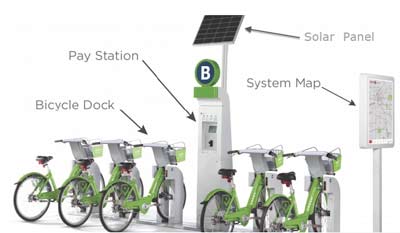
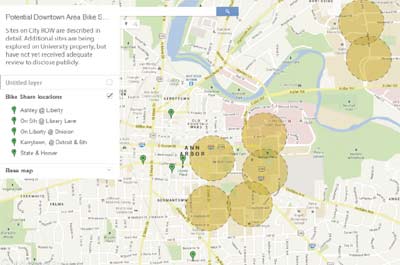
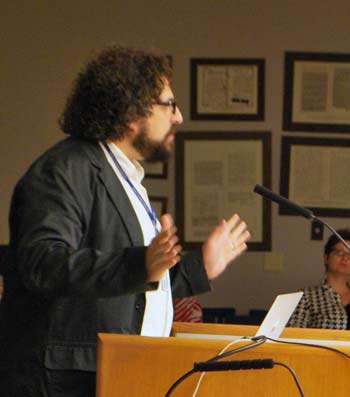
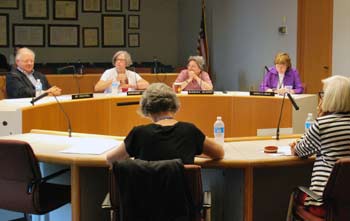

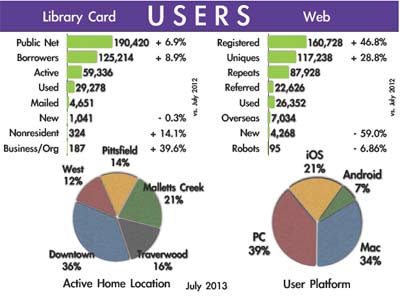
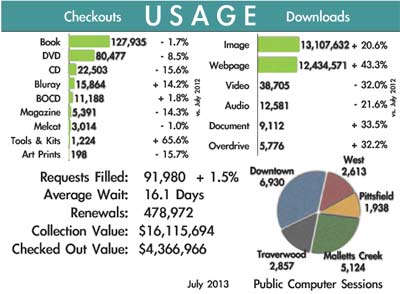
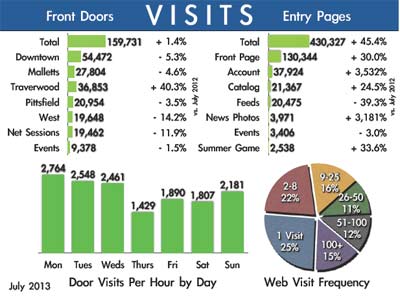
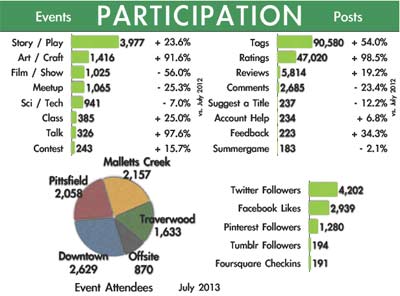
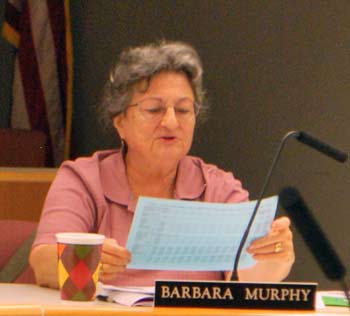

I appreciate the progressive stand the Library is taking on digital licensing.
I agree with Dave. Content creators have so many options in the rapidly evolving publishing world now, that I suspect direct licensing may become quite mainstream sooner than we all might think. It’s another way that AADL is “ahead of the curve.”